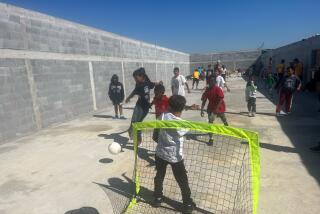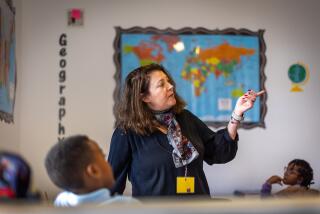A Job That Grew on Her : Sierra Madre: ‘Mama Pete’ opened her preschool 50 years ago to aid women in wartime factories. Today, women are still working and she’s still there.
In 1944, when the men went off to war the women went to work in defense factories--and their children came to Mama Pete’s.
Fifty years later, they’re still coming.
For half a century, Marjorie Peterson has presided over a wood-shingled storybook house in Sierra Madre where ceramic elves peer from the back-yard bushes and 2- to 5-year-olds get lessons on manners and ABCs--and lots of hugs.
“When the war ended, I thought everyone would go home and that would be the end of our day-care job,” recalls Peterson, now 78. “But they didn’t. Mothers are still working and we still have children here.”
What started as an ad-hoc nursery during the war years bloomed into a full-fledged preschool named Mama Pete’s for its founder, with a playground and swimming pool. And her toddlers have grown into parents, even grandparents.
Bob Manuel, now a 33-year-old Monrovia police officer, returns to the school each year to give the children safety lessons. Elisa Hicks came to Mama Pete’s in diapers and 20 years later is now a full-time teacher’s aide.
The original nursery, Peterson says, “just happened by accident. I had always taken care of children--I baby-sat, taught Sunday school. During the war, women were looking for someone to care for their children. So I took in the first baby, and before I knew it I had 10 of them.”
The working mothers were “Rosie the Riveters” who, in the absence of their husbands, earned a living and contributed to the war effort by crafting airplane parts and precision instruments at firms such as Douglas Aircraft and Lockheed.
The center operated around the clock then, catering to the 24-hour production schedule at defense plants. At midnight, when the swing shift ended and the graveyard shift began, Peterson would wake to receive sleeping infants and roust others from their cribs to return to their mothers.
“I used to have nightmares that I gave the wrong children to the wrong parents, or that I ran out of children and didn’t have any left when the parents came,” she remembers, laughing.
Some busy mothers boarded their children there all week, bringing them home only on Sundays. In those days, she says, “it was really more like foster care than day care.”
Her own son and daughter mixed easily with her little charges. “We treated all the children like they were all ours, so they were all like brothers and sisters.”
One baby girl, left for a year by an unwed mother, nearly became a part of their family. The mother reclaimed the child after Peterson and her husband expressed an interest in adopting her. Twenty-two years later, she returned to visit Mama Pete.
“It was hard to imagine not having seen her from 1 year old to 23,” Peterson says.
She was only one of Peterson’s former students who was drawn back to the school.
Elisa Hicks came to Mama Pete’s as a toddler while her mother was occupied full time with caring for her brother, who was hospitalized with spina bifida. Hicks’ father and brother died when she was 13, forcing her mother to go to work. Instead of going home to an empty house after school, Hicks began volunteering at Mama Pete’s. In her senior year of high school, she got work-study credit for the job, and during summer break from Biola University in La Mirada she taught swimming. Now 22 and recently graduated, she works full time as a teacher’s aide.
“She’s like a second mom to me,” Hicks says of Peterson, taking a break from blowing bubbles to giggling youngsters. “I like the way she treats the children here. She treats them like little people, with respect.”
When Peterson enters the classroom during a snack time, one little boy stretches his arms up for a hug. As she cuddles him, another child asks politely, “Mama Pete, can I have a hug?” That sets off a chain reaction and soon three or four beaming children are clinging to her legs.
“I’ve learned so much from her--not just about children but about life itself,” says Cathy Sieves, who has been substitute teaching at the school for 30 years. “The first day of public school, the teacher could tell a Mama Pete child because they were so well-behaved.”
Through five decades of child-rearing, Peterson has watched the way children have changed.
“They didn’t seem to be running in such a high gear all the time, 50 years ago,” she says. “I don’t know if it’s the way we live or TV. Now we’re teaching things to children they used to teach them in first grade.”
In an age when parents worry which interactive videos their children need to become computer literate, Peterson stresses simpler priorities. Preschoolers need to learn colors, shapes and alphabet letters. They need to learn manners. And they need plenty of time to play.
“Of course, they can learn a lot during playtime because they don’t even realize they’re learning,” she says.
Over the years, Peterson and her husband, who died 10 years ago, built a school building in the back yard, with an apartment on the second floor that they rent out. In the yard behind it is a swimming pool. Children are kept busy with a playhouse, a sandlot with swings and slide, a blacktop for tricycles, a crafts corner and a menagerie of pet guinea pigs, hamsters and turtles. Two preschool teachers and two teacher’s aides care for 24 students. Full-time day care costs $105 a week; half-days cost $50 a week.
During the 1984 Olympics, Peterson staged athletic games for the youngsters. A pint-sized torchbearer opened the ceremony, each child represented a country and there were chocolate gold medals for everyone. Another time she invited a movie insect trainer to bring pet tarantulas for the children to handle.
During the school’s annual safety week, another of Peterson’s alumni shows up. Manuel, the Monrovia police officer, rides in on his motorcycle to caution the children about crossing the street and about talking to strangers.
His brother’s children attend the school, and his own son is on the waiting list. Mama Pete’s is so popular that pregnant women sometimes place their unborn babies on the two-year waiting list, hoping there’ll be a place by the time they’re preschool age.
Manuel says it’s worth the wait. “Turning your kid over to someone for them to care for and teach, I couldn’t think of a better person for the job.”
More to Read
Sign up for Essential California
The most important California stories and recommendations in your inbox every morning.
You may occasionally receive promotional content from the Los Angeles Times.










